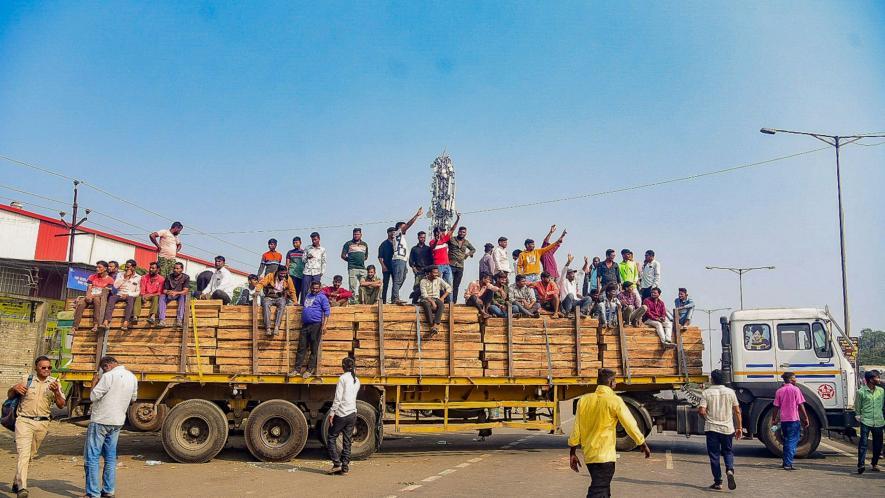Do Truck Drivers Want To Kill You?

Truck drivers shout slogans during their protest against the new penal provisions in the hit-and-run law, in Nagpur,Image Courtesy: PTI
The recent protests against the new hit-and-run law under the Bharatiya Nyaya Sanhita (BNS) are puzzling to many. Videos and photos of protestors lining up roads with rocks, swathes of buses and trucks parked in protest against the new law, and petrol pumps filled beyond capacity, anticipating a fuel shortage, are hitting the internet every hour. Comment sections are divided. Some argue in favour of the protesting drivers. Others accuse them of being criminals or having the potential to become criminals in the future. If the latter is to be believed, every truck and bus driver in the country drinks before driving, cannot obey a traffic law to save their life and cares little about those in other vehicles. This raises a very simple question. Are truck drivers out to kill you? If not, why are they protesting the new law?
According to the report released by the Ministry of Road Transport and Highways, there were 67,387 instances of hit-and-run cases in 2022, which led to the deaths of 30,486 people. This accounts for 14.6% of all road accidents and 18.1% of all road accident-related fatalities in 2022. The numbers are up by almost 17.5% since 2021. The report contains some additional data that could inform our understanding of hit-and-run cases and road accidents in general. The number of accidents per 10,000 vehicles has gone down from 814 in 1970 to just 11 in 2020. This means that despite an increase in the total number of vehicles on the road, the total number of accidents has reduced significantly since 1970. The vehicular density of India’s roads has also gone up, meaning more and more vehicles are travelling within a particular area of the road, leading to increased traffic and congestion.
What does this data tell us, then? It tells us that Indians are driving more and more safely when taking into account the increased length of roads, increased vehicle density, and the number of accidents per 10,000 vehicles. The increased number of hit-and-run cases is not indicative of increased rashness in driving but simply the number of vehicles on the road increasing, which increases the likelihood of accidents.
Let us now talk about India’s drivers. Save Life Foundation’s report on truck driving in India reveals incredible details about the working conditions of our country’s drivers. Part of an increasingly exploited workforce, the average driver drives around 12 hours daily, covering an average of 417 km daily. Almost half the respondents said they work even when fatigued or sleepy, which significantly increases the likelihood of accidents and deaths. This may also be part of the reason why trucks/lorries caused the third-highest share of crashes in 2018. 93% of the respondents confirmed that “other than salary/wages, they do not get any social security benefits (such as provident fund, pension, health insurance, life insurance, gratuity, etc.).” 9 out of 10 respondents also confirmed that they did not undergo any professional training before getting a driving license. A 2020 study also looked into the underlying conditions behind road accidents involving trucks, and the findings suggest that some of the root causes behind such accidents are high work pressure, deadlines, frequent technical failures in the vehicle, etc.
All of this data helps us better understand what is at stake for truck drivers when they come out on the streets and protest the new BNS law. Truck drivers in India are part of an industry that must maintain strict deadlines, and the remuneration for work done is far from optimal. Along with this, the working conditions, in our assessment, are the root cause of such accidents. It is no surprise that workers who drive anywhere between 12-16 hours a day on faulty vehicles, tight deadlines, and continuous trips are part of accidents which lead to death. Companies which own such trucks care little about providing adequate training, providing functioning trucks, or enough time to make deliveries. The law, in this situation, acts as a band-aid over a proverbial severed leg. If the labour laws and laws related to trucking in our country had been more pro-worker, many such accidents could have been avoided from taking place altogether. Increasing the term of the sentence, or the fine to be paid, is no solution to a problem that relates directly to horrible working conditions and survival-level wages.
(The author is a master's student of Development Studies from Ambedkar University, Delhi. Views expressed are personal.)
Get the latest reports & analysis with people's perspective on Protests, movements & deep analytical videos, discussions of the current affairs in your Telegram app. Subscribe to NewsClick's Telegram channel & get Real-Time updates on stories, as they get published on our website.
























